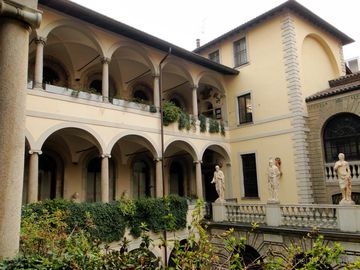

The Ambrose Art Gallery is not only an exquisite museum; it was once a center of learning and cultural activity, as well as an art academy.
The Ambrosiana, as it is called by the Milanese, was founded by the Archbishop of Milan Cardinal Federico Borromeo in 1604. He had recently returned from Rome where he was impressed by the city's artistic and cultural dynamics. He thus created a College of Doctors - twelve ecclesiastics and four lay - to oversee the foundation and evolution of an artistic, literary and scientific institution. The archbishop wanted his cultural institution to become one of universal service, glorifying God and integrally promoting human values. While Borromini's envoys were traveling the world and collecting important prints and manuscripts, he commissioned architects Lelio Buzzi and Francesco Maria Richini to construct a library that would house the collection. In 1611 architect Fabio Mangone enlarged the structure by adding a wing for the art academy and Borrimini's private paintings, which included works by Raphael, Caravaggio, Leonardo, Botticelli, Titian and Bernardino Luini. Throughout the centuries the building underwent additional changes and expansions, such as the annexation in 1928 of a religious institute and the Church of Santa Maria Maddalena al Santo Sepolcro, which had been built in the 11th century. The Ambrosiana was modernized during the restoration from the World War II bombings and is now one of the main tourist stops in the city.
The original library contained 30,000 prints and 8,000 manuscripts, which were brought from other European countries, as well as faraway lands such as Arabia, China, Russia, India and Japan. In 1623 Galileo Galilei called it "a heroic and immortal library." Other nobleman and wealthy merchants also participated in the institute's growth by donating works, whether they were paintings or scrolls, of inestimable value. Leonardo Da Vinci's codes gradually started making their way into the library after it was understood that his genius was not an esoteric phenomenon but belonged to the world. Another treasure that can be found in the Ambrosiana is a manuscript with a literary work coming from the pen of the great ancient Roman poet, Virgil. The manuscript belonged to Petrarch, who annotated it and had painter Simone Martini paint a miniature on the cover.
Today the art gallery consists of twenty-four rooms. The paintings that were donated by Borromeo and that comprise the nucleus of the museum's collection are located in rooms 1, 4, 5, 6 and 7. Among the most famous works in those rooms are Titian's Old Man in Armor, Raphael's sketch for the School of Athens, a fresco that can be found in the Vatican Museum, and Caravaggio's Basket of Fruit, which Borromeo brought back with him from Rome. Caravaggio's precise, colorful and symbolic canvas is said to have been the first still life in Italian painting.
Other fascinating paintings include Leonardo's Portrait of a Musician, in room 2, Botticelli's Madanna del Padiglione, also in room 2, and Veronese's Portrait of a Man in the Studio, in room 12. Room 19 is bedecked with works by Italy's greatest 19th century portraitist, Francesco Hayez.